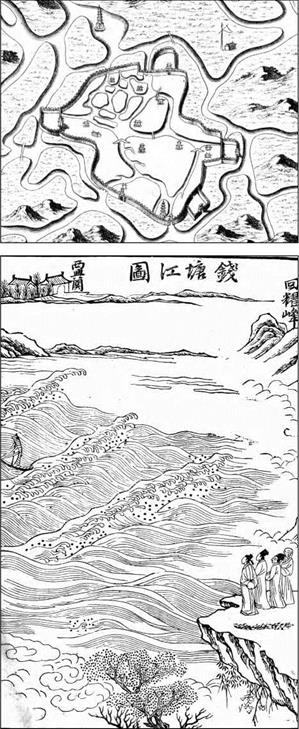A wall against the sea – the tidal bore of Hangzhou
The major city of Hangzhou, prominent in the account of Marco Polo as we have seen, is located at the head of an estuary that is nearly 100 km long. The land there is quite flat and thus exposed to the tidal surge and waves associated with strong storms. Moreover in this particular estuary there is an additional extraordinary phenomenon: one of the largest tidal bores in the world.
The tidal bore is a wavelike disturbance, or a series of disturbances, resulting from the progressive steepening of the tidal wave as it propagates into a sufficiently long and shallow estuary. At Hangzhou in the Chien-Thang estuary the mean height of the bore is the order of two meters. But during equinox tides, it can reach 7 or 8 meters. It is very special to be able to come to see this bore during extreme tides, a truly festive occasion. Here is a poetic description dating from the 13th century that gives some idea of the power of this phenomenon:
“The tidal bore on the Che River is one of the great sights of the world. It reaches its full force from the sixteenth to the eighteenth of the month. When it begins to arise far away at Ocean Gate, it appears but a silver-thread; but as it gradually approaches, it becomes a wall of jade, a snow-laden ridge, bordering the sky on its way. Its gigantic roar is like thunder as it convulses, shakes, dashes, and shoots forth, swallowing up the sky and inundating the sun, for its force is supremely vigorous. “[441]

 Figure 8.16 The city of Huzhou, near the south bank of Taihu lake. This city is linked to Hangzhou and to the Grand Canal by a network of canals. “It is one of the largest and most considerable cities of China, due to its richness, its commerce, the fertility of its land, and by the beauty of its waters and mountains.” (du Halde, 1735 – ancient archives ENPC).
Figure 8.16 The city of Huzhou, near the south bank of Taihu lake. This city is linked to Hangzhou and to the Grand Canal by a network of canals. “It is one of the largest and most considerable cities of China, due to its richness, its commerce, the fertility of its land, and by the beauty of its waters and mountains.” (du Halde, 1735 – ancient archives ENPC).
The earliest land protection works along this estuary date from the time of the latter Han, around 85 AD. The name of the estuary, the estuary of the dike of coins, also dates from this period. The first builder of the dike was the governor of the region called Hua Hsin. He had called upon the people of the region to bring earth and stones for the project, for which they were paid in coins. The dike is exposed to the force of the waves, and the sea apparently destroyed the first few attempted structures. There ensued debates on the mode of construction that should be adopted. Should the dike be built of earth with a rock armor layer, a costly solution? Or should it be built more simply of earth mixed with straw and brush, as were many other dikes and dams? One can also imagine a structure based on rocks contained in bamboo cages, anchored with stakes and stabilized with iron chains, an assembly commonly used to repair fluvial dike breaches. Work was conducted in 910, in 1014, again in 1035, then again in 1169…. Gates were put in place to let the water flow seaward at low tide.
A continuous rock dike supported by an earth fill is eventually achieved in 1368. In the Ming Dynasty, in 1448, a solution is finally found that has remained satisfactory up to the present time. This consists of constructing a wall of cut stone interconnected with steel pins and with a stairstep profile facing the waves, better to break their force. Its foundation is made of wood piles, and the wall leans against old rock outcrops as well as against an earth fill.[442] [443] This type of construction is similar to that used for the large dike of Hongze lake described earlier.
80
Initially this maritime dike was probably about 80 km long. Today, it is more than
350 km long, and its crest rises more than eight meters above sea level.[444] [445]






Leave a reply